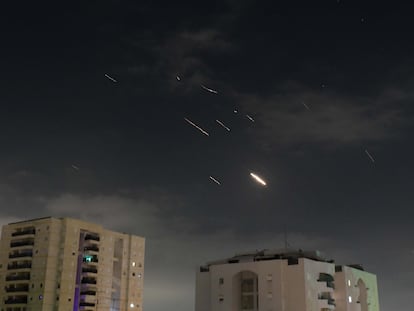Iran’s powerful missile and drone arsenal
Tehran has just over 3,000 ballistic missiles, according to a U.S. estimate. Nine models of these projectiles have the capacity to reach Israeli territory


Iran has one of the largest missile arsenals in the Middle East, with more than 3,000 ballistic missiles, according to an estimate released in 2022 by the U.S. Central Command. In the last decade, the country has significantly improved the precision of its missiles that have been considered a threat by the West for years. The Iranian weaponry is conventional. The country does not yet have nuclear weapons, but several of its missiles could carry a nuclear payload if Iran were to develop that type of weaponry.
According to the Arms Control Association, an American non-governmental organization based in Washington, cited by the Israeli newspaper The Times of Israel, Iranian missiles are largely based on North Korean and Russian designs, and perfected with Chinese technology. These missiles are mainly short and medium range.
In the last decade, Tehran has also become a major producer and exporter of drones. According to the U.S. Institute for Peace, Iran has manufactured thousands of advanced surveillance, reconnaissance and combat drones. What’s more, Iranian drones have become one of the greatest assets of the so-called Axis of Resistance (Iran, Hezbollah, the Houthis of Yemen and the pro-Iranian militias of Iraq and Syria) and Russia has frequently used them in its attacks against Ukraine.
Among short- and medium-range ballistic missiles, models such as the Sejjil stand out, a medium-range ballistic missile developed in part with Iranian technology, which is capable of carrying a payload of around 700 kilograms and reaching a target up to 1,550 miles (2,500 kilometers) away. The distance between Tehran and Tel Aviv is just under 1,240 miles (2,000 kilometers). Another missile with a somewhat shorter range, the Kheibar, has a maximum range of 1,240 miles. Manufactured by the Ministry of Defense of the Islamic Republic of Iran, it can carry a 1,500-kilo payload, while the Haj Qasem missile can hit a target up to 870 miles (1,400 kilometers) away.
In total, it is estimated that Iran has nine types of missiles with enough range to reach Israeli territory. Additionally, last June, Iranian authorities unveiled what the country’s regime described as its first domestically-made hypersonic ballistic missile, according to Iran’s state news agency IRNA. Hypersonic missiles can fly at least five times faster than the speed of sound and follow a complex trajectory, making it difficult for them to be intercepted by air defense systems.
In recent months, Iran has used these missiles against Israeli interests and insurgencies hostile to its regime in several countries in the region. On January 16, the Revolutionary Guard claimed to have attacked the Israeli spy headquarters in Iraqi Kurdistan with this weapon. A day earlier, Iran had launched missiles and drones against the bases of the Baloch insurgency in the Pakistani province of Balochistan. Pakistan’s government condemned the attack, accusing Iran of killing two children and calling it an “unprovoked violation” of its airspace.
When a cruise missile and drone attack hit Saudi oil company Aramco’s facilities in Abqaiq and Khurais in eastern Saudi Arabia on September 14, 2019, neither Saudi Arabia nor the United States believed that Yemen’s Houthi militants were the real perpetrators. They did not have the weapons, technology or intelligence information to carry out an attack of that magnitude. Both countries believed that the main supporter of the Yemeni rebels was behind the attack: Iran.
Sign up for our weekly newsletter to get more English-language news coverage from EL PAÍS USA Edition
Tu suscripción se está usando en otro dispositivo
¿Quieres añadir otro usuario a tu suscripción?
Si continúas leyendo en este dispositivo, no se podrá leer en el otro.
FlechaTu suscripción se está usando en otro dispositivo y solo puedes acceder a EL PAÍS desde un dispositivo a la vez.
Si quieres compartir tu cuenta, cambia tu suscripción a la modalidad Premium, así podrás añadir otro usuario. Cada uno accederá con su propia cuenta de email, lo que os permitirá personalizar vuestra experiencia en EL PAÍS.
¿Tienes una suscripción de empresa? Accede aquí para contratar más cuentas.
En el caso de no saber quién está usando tu cuenta, te recomendamos cambiar tu contraseña aquí.
Si decides continuar compartiendo tu cuenta, este mensaje se mostrará en tu dispositivo y en el de la otra persona que está usando tu cuenta de forma indefinida, afectando a tu experiencia de lectura. Puedes consultar aquí los términos y condiciones de la suscripción digital.










































